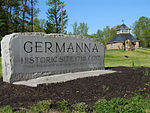Shady Grove Corner, Virginia
Northern Virginia geography stubsUnincorporated communities in Spotsylvania County, VirginiaUnincorporated communities in VirginiaUse mdy dates from July 2023
Shady Grove Corner is an unincorporated community in Spotsylvania County, in the U.S. state of Virginia. Shady Grove Corner is where Robertson Run and Cartharpin Run join to form the Po River. The Shady Grove Church was built here prior to the Civil War. During the Battle of Spotsylvania Court House in 1864, several Confederate regiments used Shady Grove corner as a marching and resting location. It was the site of the Whitehall Mine, one of several gold mines in Spotsylvania County.
Excerpt from the Wikipedia article Shady Grove Corner, Virginia (License: CC BY-SA 3.0, Authors).Shady Grove Corner, Virginia
West Catharpin Road,
Geographical coordinates (GPS) Address Nearby Places Show on map
Geographical coordinates (GPS)
| Latitude | Longitude |
|---|---|
| N 38.221666666667 ° | E -77.711111111111 ° |
Address
West Catharpin Road 10812
22551
Virginia, United States
Open on Google Maps




